developing soil
We moved to central TX, a beautiful area but soils are thin. Most prominent feature is exposed limestone & caliche--a calcium carbonate formed from rainwater percolating through limestone.
Whoa! It's like the garden of Eden! What rose wouldn't die to live here?
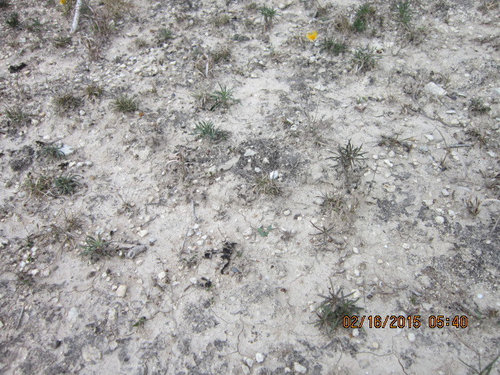
Sometimes caliche is found as concrete like deposits just under the surface:
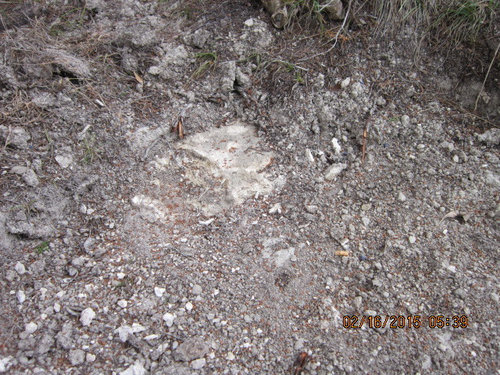
So planting here pretty much necessitates building on top. sometimes you can pick-axe through the caliche to form a hole, but this can result in a plant reacting like it's planted in a concrete pot--which it almost is. If you dig a hole, it has to be a big roomy one. Sometimes you can dig through a caliche deposit but we're finding that once we hit it, we can't dig through.
Here's what we do: plant a tree in a wide hole, backfill with good soil & continually add mulch & organic material.
Comments (31)
bluegirl_gw
Original Author9 years ago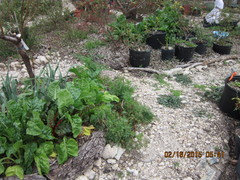
The caliche junk we pick out gets thrown on cardboard or paper to form trails. The hole is bordered by logs to hold in moisture & mulch. This is a peach tree with Swiss Chard border.
As we plant things, the beds are gradually merging to form bigger beds.
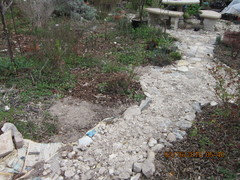
With caliche trails in between
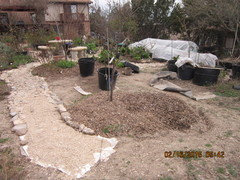
Here's the oldest bed, it's full of roses

Not blooming now, but it looked fine this spring.
It's a slow, continuous process. We used a similar technique to "colonize" good planting beds when we lived in an area of heavy clay soil.
Related Professionals
Beavercreek Landscape Architects & Landscape Designers · Alpharetta Landscape Contractors · Apollo Beach Landscape Contractors · Bridgeport Landscape Contractors · Canton Landscape Contractors · Essex Landscape Contractors · Madera Landscape Contractors · New Cassel Landscape Contractors · Riverview Landscape Contractors · Tewksbury Landscape Contractors · Vineyard Landscape Contractors · Waipahu Landscape Contractors · Waltham Landscape Contractors · Markham Landscape Contractors · Merrifield Landscape Contractorsstrawchicago z5
9 years agolast modified: 9 years agoHi Bluegirl: Those pics. are great ... thank you. They really demonstrate how to build up a garden organically. Your white lime stones work great in keeping the weeds & grass out ... the finer the particle, the more effective. When I used horse manure (limed), I had zero weeds in my garden. I got tons of free gritty lime from a nearby dolomitic quarry. Dolomitic has both calcium and magnesium. I spread that stuff to control weeds.
My neighbor once bought top soil (from Menards) with tons of weed-seeds. There were at least 10 varieties of weeds sprouting on her lawn. Then she hired a professional lawn company to fix the problem ... they sprinkled lime on her lawn. Last year I messed up my lawn: I tried the organic approach: fertilize with Milorganite (sewage sludge, or recycled human poop). Mill's Magic Rose fertilizer has Milorganite.
Milorganite isn't appropriate for lawn, since the nitrogen is too low, and high in phosphorus ... phosphorus made the weeds flower and they spread like wildfire. So I bought Scott's Weed & Feed to kill the weeds, and the chemicals really destroyed my hands. For my lawn: What I should had done was to use a HIGH NITROGEN, without weed killer-chemicals. Then use lime to sprinkle onto of the weeds. I dug up dandelions by hand, but next year, I'll sprinkle concentrated vinegar into the hole ... dandelions like it alkaline, we have tons of them here.
I found a link in Pinterest which show how to build a brick-border to keep the weeds out: How to build a brick border to keep weeds out
strawchicago z5
9 years agoBelow is a picture of my garden. We get 1 foot of alkaline dark heavy clay, the bottom is grayish dolomitic lime (calcium & magnesium). The grass likes like slightly alkaline, and is very aggressive here. I no longer use Weed & Feed with dangerous weed-kill chemicals. I simply use a fertilizer high in nitrogen, and it works just as well as Weed & Feed.
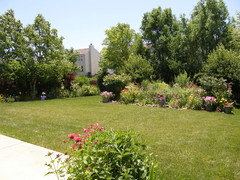
jim1961 / Central Pennsylvania / Zone 6
9 years agoYour doing a wonderful job bluegirl_gw! Love all the pics walking us through so we can actually see what your doing... :)
Nice pic of your garden Straw!
strawchicago z5
9 years agoHi Jim: I agree that bluegirl did a wonderful job in her garden, I am amazed at how organized it is.
Hi Bluegirl: I love your Swiss Chard beneath the Peach tree, that's a great idea. Greens taste better when it's partial shade. I once planted Bok Choy in full sun .. it became tough and fibrous.
bluegirl_gw
Original Author9 years agothank you, thank you!
Straw, your place is gorgeous, as usual. Good healthy soil & plants are just radiant, aren't they?
Swiss chard is my favorite green. I like the leaves, the flashy appearance & I use its stems instead of celery (which we can't grow). It's so easy. I like spinach, but it's strictly a winter green--can't take the heat here. Swiss chard not only grows & tastes good all year, it's been a long-term perennial AND it throws fertile seed. I'm pulling it out of pots & beds where it's seeded itself. I'm amazed, learn something everyday.
Next favorite green is chickweed--I look forward to it every spring. I raise a lot of pet birds & birds should always have fresh organic greens available as seed diets are notoriously deficient in vitamin A & D3. It's the only green my birds consume enthusiastically--& they do love it, finely chopped.
Me too :D
I read somewhere that the name may have originated because folks fed their baby chicks--ordered in the spring--on the readily available nutritious chickweed, which also starts growing thickly in spring. Dunno, but it's a shame people poison their yards to get rid of it--it's innocuous, beneficial, nutritious & dies down with summer heat anyway. I always try to keep a bit going through the year in a shady moist place.strawchicago z5
9 years agoThank you, Bluegirl, for the info. on Swiss Chard. I will order that seed for my Mom. My favorite place to order is Johnny Selected Seeds ... great customer service & good prices. I made a beef stew with beans and Swiss Chard, it's really yummy, although I could had done Swiss Chard with chicken and white beans too.
I have some chickweed growing in dry & yellowish limestone ... but my most invasive weed is garlic mustard (native to Illinois). Purslane weed is high in Omega-3 ... I tried boiling that, but it was nasty ... I think it tastes best RAW in salad to retain its Omega-3. Purslane is so invasive, so I dislike that weed. I love chickweed since it's NOT invasive, and can be easily pulled out.
I could eat Swiss Chard everyday and still love it. I buy them when fresh at grocery store, boil it for a few minutes, then freeze them immediately. Same with beets green, it's yummier than beets itself.
KarenPA_6b
9 years agoThank you very much, bluegirl_gw for sharing your info and experience. I have learned alot from your post. Next time instead of having to pay someone to haul the twigs and branches that I pruned off my shrubs and trees away, I can use them to hold leaves around my fruit trees. Just wonderful.
strawchicago z5
9 years agoHi Karen: Agree... that's a great idea. Folks also use branches & twigs to make "Hugel raised bed". They put biggest branches 1st, and as it goes upwards, smaller twigs, and lastly good dirt on top. Good drainage is a must for long-stick roots like Dr. Huey, which some roses are grafted on. A guy posted his "Hugel rose pot" in this forum (with vertical branches at the bottom) ... his was the most healthy rose I have seen.
KarenPA_6b
9 years agoOh, yes. I should apply these techniques to my rose beds as well. You give so much information on this forum that I am still trying to learn from your experience and knowledge. I was not very good with chemistry in school so it is going to take me sometime to get all this. I really like to grow things organically or as naturally as I can.
strawchicago z5
9 years agoHi Jim: if not for your encouragement, I would had quit posting years ago. You positive force is valuable to this forum. Nice profile picture, Jim.
Hi Karen: I love that pink rose as your profile name. What's the name of that rose? Sorry for my detailed chemical analysis ... the only reason why I do so is to defend myself. Josh from TX asked me in Rose forum how to deepen roses' colors ... I posted on the trace elements of molasses, plus lowering the pH. Then people started to nit-picking my answer .. some said plenty of water deepens the color of roses! From that time on I have to back up my experiments with tons of data.
But I'm NOT a good cook, that's why I posted "Products & recipes & roses that you love". I hope to learn some tried-and-true good recipes .... I recently tested "Best meatloaf" recipe and it fell apart ... should be 2 eggs to hold the meat together, plus more fried onions to make it moist. Karen, if you have some good recipes, I would love to learn from you .. thanks for posting.
KarenPA_6b
9 years agoHi Straw. I am sorry but I wish my cooking is as good and consistent as my gardening. The results come out sometimes good and sometimes terrible. Thanks, the rose is International Herald Tribune. I only have it for about 1.5 year so the own root plant is still immature. I like the form and color of the flower. As far as fragrance, I have not smelled any yet.
I really like to grow my plants in healthy soil as much as possible. Because I just started seriously gardening 3 years ago, the soil around my house still needs alot of improvement. (It used to be lawn) I don't have enough compost to spread around the plants. My husband bought me a chipper last year. Hopefully this will help me to build up my soil better in the coming years. Last year, I was able to shred about 30 bags of leaves and a pile of twigs to spread around the flower and vegetable beds. I had no idea about the different types of minerals that the plants need to live and flourish. Basically, I have alot to learn. The nice thing about my area is that I can easily get all these minerals at a very reasonable price.
Have you ever tried Espoma Hollytone on roses? It is an organic formula and is currently on sale at Costco for $12.99. The only ingredient in this formula that worries me is the 5% sulfur. And some percent of this sulfur is elemental sulfer. I hear that elemental sulfur can burn roots. Is this true?jim1961 / Central Pennsylvania / Zone 6
9 years agoThanks Straw! I put my sunglasses on in my pic because I am so ready for Spring! lol
KarenPA asked you a question Straw in the above post of hers...
strawchicago z5
9 years agoHi Karen: I tried Espoma Hollytone along with alfalfa meal in the planting hole, when I dug it up, I didn't see any earthworms, that could be from the sulfur ... that stuff burns my hands, if not washed off immediately. Hollytone NPK is 4-3-4, compared to Tomato Tone NPK of 3-4-6. I WAS NOT IMPRESSED with the flowering of roses, with Hollytone in the planting hole. It reeked of chicken manure .. chicken manure is hot, should not be in the planting hole. It has bone meal ... that's why sulfur is added (bonemeal can't be utilized if the pH is above 7).
I really like Standlee alfalfa pellets in the planting hole. way-better flowering than Tomato Tone. TomatoTone is great for tomato, but roses are sensitive to salt, and Standlee alfala pellets (for horse) is the only one without salt or sugar added. The pellets fed to rabbits isn't good for roses ... has additives. I tested Standlee alfalfa pellets in late fall, roses bloom a lot plus healthy despite the cold weather. I called my feedstore in advance, so they ordered for me (without charge) ... I picked it up, it's a HUGE BAG, worth the money with NPK 2.5-1-2, much better than leaves. Standlee alfalfa pellets for horse. The longer I grow roses, the more I realize the lethal effect of salt, including chicken manure. I had seen root-burn when I put chicken manure around the stem in early spring. Chicken manure is saltiest among the manures. Standlee Alfalfa pellets is superior to alfalfa meal. Alfalfa meal is dusty and stinky, versus fresh-scent Standlee alfalfa pellets. Alfalfa meal glues up with clay soil into concrete, but alfalfa pellets is slower released, larger particle, so one doesn't risk burning from the heat given off by decomposition of organic matter in the planting hole.
jim1961 / Central Pennsylvania / Zone 6
9 years agoGreat post Straw! Here we have soft clay soil... Very easy to dig but still a heavier type soil. Our soil seems to retain salts fairly easy from using most fertilizers so I manly only top dress with homemade compost now... (composted leaves, grass, small branches etc. etc.) I still place alittle used coffee grounds around the rose bushes once or twice a year. My thoughts are that used coffee grounds and compost cause the worm population to increase thus the worms help loosen up the soil plus the poop from worms has to be a added benefit...lol... (Alfalfa pellets such as Straw mentions would do the same thing...) My wife drinks coffee like its going out of style so I have used grounds on hand...lol
KarenPA_6b
9 years agoHi Jim! Although my husband drinks alot of coffee, it is hardly enough for my use. Right now, I am saving veggie scraps for compost.
Straw, thank you so much for explaining the hollytone. It sounds a bad idea. Now that you got me thinking about recipes that work, I do have one that everyone in my family loves. Have you ever made yeast waffles? They are really tasty but rather high in fat. Though if you use grassfed butter, it should not be too bad. Let me know if you are interested in this recipe.
strawchicago z5
9 years agoHi Karen: You are a God-sent, I love you for that offer !! Yes, I'm interested, Thank you. My kid adores waffle, but lately I messed up badly: I put too much healthy stuff like flax seeds which made it sticks to the waffle machine. I drizzle fish oil and maple syrup (to disguise the fish oil) ... that's the only way I can give her fish oil, without her knowing. Fish oil is known for brain and speech development in children. Yeast waffles sounds yummy, I don't like to put baking soda in waffle .. it makes the waffle too bitter and salty.
Hi Jim: I tested Encap dried compost (from leaves & cow manure) sold at Menards for $2 per bag. That didn't work as well as Standlee alfalfa pellets .. which produced the most blooms .. 5 blooms on Carding Mill, only 3 months own-root. Reason? the NPK of Encap compost was MUCH LOWER than alfalfa pellets, plus the cow manure has plenty of salt. Salt drives down potassium (necessary for blooming and root development).
Alfalfa pellets has the perfect ratio of nitrogen to potassium NPK 2.5-1-2, plus decent calcium for root-development. Plus being chunky it fluffs up compact clay soil, rather than gluing up like fine-particle alfalfa meal or peat moss. I already tried peat moss (pH 4) mixed in with my alkaline clay (pH 7.7) ... that was major disaster .. zero blooming. When I dug that up, fine-particle peat moss glued up with my clay ... roots can't grow.
Even large-chunk composted pine bark is useful for pots. MiracleGro Organic potting soil has large chunk pine barks mixed in. At first I was annoyed, but after getting lots of blooms, I didn't mind. MiracleGro ORGANIC potting soil was tested by pepper-growers against a variety of potting soils, and MG Organic lead the pack in fruit development. The most bloom-rose I had seen was Easy Elegance in a CHUNKY composted pine-barks pot, mixed with blue fertilizer granules NPK 12-12-17. Large chunks mixed in with soil create air pockets, which gives oxygen for best root-growth. Best root-growth means more flowering.
KarenPA_6b
9 years agoStraw, the recipe does contain a quarter tsp of baking soda. I think that it helps to make the waffles crispy. Here is the waffle recipe:
Ingredients
0.5 cup warm water at about 110 degrees
1.5tsp yeast
1tsp sugar
2cups milk
2cups all-purpose flour
0.5cup(1 stick)unsalted butter, melted.
1.5tsp vanilla extract
1tsp salt
2 eggs
0.25tsp baking soda
1. In a large bowl, combine the water and yeast with the sugar. Set aside until the yeast dissolves and mixture is foamy, about 5 minutes.
2. Add the milk, flour, butter, vanilla, salt. Stir to blend. Cover the bowl with plastic wrap and set aside overnight at room temperature.
3.Heat the wafflemaker. I use one that flips. This gives the best result.
4.Just before cooking the waffle, whisk the eggs and the baking soda into the yeast mixture. Your batter is ready for the wafflemaker.
strawchicago z5
9 years agoThank you, Karen, I make it tonight. I don't mind 1/4 tsp baking soda, it's the recipe that calls for 1 Tablespoon baking soda which makes it bitter.
jim1961 / Central Pennsylvania / Zone 6
9 years agolast modified: 9 years agoI use food scraps in my compost also... Alittle bit of everything... I apply uncomposted leaves, small twigs, etc. around also...I don't trust store bought compost because I really do not know what's in it...
Yummmmmmmmm Waffles! :-)
KarenPA_6b
9 years agolast modified: 9 years agoSure, let me know how they turn out for you. They are a bit rich. I wonder if you can get away with a quarter cup of butter and low fat milk. I have never tried to reduce the butter or use lowfat milk. My DH is a finicky eater. He can tell if I tweak a recipe even a little bit.
I am with you on that Jim. I do not buy bagged compost either for that very reason.strawchicago z5
9 years agoHi Karen: The batch which I made on Monday didn't work ... the yeast was too old. When I looked up, I should had frozen my yeast to keep it alive longer. Last night (Fri.) I used the new yeast hubby bought, but decreased the fat drastically, plus I sub. apple sauce for water & used half-half instead of milk. In the morning, it looked great & nice and fluffy. I then beat in eggs, and it was delicious with a tart taste (I intended that way, since I added blueberries).
The next batch I'll use 1/2 the yeast, and leave OUTSIDE of the refrigerator. Our room temp. at night is quite cold. I'll increase apple sauce & blueberry since I like it tart.
KarenPA_6b
9 years agoYou are brave and adventurous cook, straw. I am not that good of a cook to tweak recipes. They never turn out well. With gardening, it is a different matter. I like to try different things to see what works. I saw the post about organic insecticide spray using Kirk's Castille soap and I can't wait to use it this year to control a variety of bugs that love roses. I have already purchased a stash just in case. I wonder if I can spray it on fruit trees too.
jim1961 / Central Pennsylvania / Zone 6
9 years agoThe only insects that bothers us and does a lot of damage is Rose Slugs (which are here from May to November. Also Aphids but they do not do much damage at all here so I do not even consider them a pest.
strawchicago z5
8 years agoBrought up this thread to post pics. of my pH 7.7 alkaline clay in wet June. Will get horse manure to mulch my garden. Although there's a big pile of mulch nearby (free from the village), I don't like wood-chips ... that really robs the soil of nitrogen, and clover sprouts like crazy. Does anyone know how to get rid of clover permanently? I threw cheap chicken-manure on them, and that didn't help. Plus those long stringing weeds (with whitish morning-glory-flower) thrive where nitrogen is deficient. Picture of lilies and perennials taken June 17, after weeks of rain:
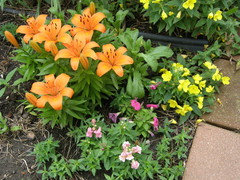
jim1961 / Central Pennsylvania / Zone 6
8 years agoWhite clover in grass /yards? We are getting tons of White Clover here right now in our grass... I don't worry about it here because the bumble and honey bees love it year after year... I enjoy watching the bees.... My wife not so much...lol
Great looking flowers Straw!
strawchicago z5
8 years agolast modified: 8 years agoJust an update: I got rid of my clover by mulching with alfalfa hay, which suppress ALL weeds plus supply nitrogen to the soil. NPK of alfalfa hay is 3-1-2. My soil is super-high in magnesium, so the soil test recommends adding gypsum (calcium sulfate) to lower soil pH, and to release calcium.
Here's good info. from Yahoo: "Not all clay soils benefit from gypsum. however if your soil shows signs of the following: is slippery and sticky when wet, tends to slump and get very muddy during rain, forms a crust on drying, allows only slow entry of water, and does not break into anything smaller than large clods during digging; then it is likely that applying gypsum to it will improve its structure. Gypsum isn't a clay breaker is such, rather it is more of a clay aggregate thickner. meaning that the clay particles are very tiny and very close together with no space between, by applying gypsum the clay particles stick together creating larger particles with more space between (larger aggregates)... Winnerman · 7 years ago
**** From StrawChicago: gypsum takes at least 1 year to work, before the big particles get broken down further with rain-water. A better way to loosen up hardened clay is from below link: http://web.extension.illinois.edu/askextension/thisQuestion.cfm?ThreadID=13910&catID=154&AskSiteID=34
Greg Stack- Extension Horticulturist gstack@illinois.edu
"Many people think that gypsum is the magic cure for clay soils. While gypsum is often suggested to help loosen up clay soil by getting between the particles and helping to floculate or open up the soil for better air and ater movement it often takes time and if a plant is there again it can't be incorporated the way it should be. The only way I think you can help a tight clay soil under sod is to do vigorous core cultivation. This means using a machine that puts holes into the ground that are at least 4 inches deep and about 1/2 to 3/4 inch in diameter with the holes being no more than 2 inches apart. After that you can topdress with good soil that is worked into the holes and allows air and water to start moving down and supporting good root structure. Doing this coring regularly will eventually start to "replace" the soil one core at a time allowing a better soil environment for root development. "
**** From Straw: I agree with the above approach, except I use coarse sand to fill the aeration-holes. Coarse sand DOES NOT GLUE UP with my high magnesium clay, I dug up many areas of my heavy clay mixed with coarse sand, and a decade later, the sand remains nice & fluffy rather than gluing up with clay like with peat moss, alfalfa, compost, and wood chips.
strawchicago z5
8 years agoBelow is a picture of "Sun Sugar" yellow-cherry tomato with 1/2 Menards cow manure and my native clay. When I mixed that manure into the planting hole, I notice that it was compact & hardened, rather than fluffy. They put lime in to deodorize, which hardened the manure. The result is a pale plant, but lots of fruits. I get the same result when I used cow-manure on La Reine rose: plant became short & stunt, yellow leaves, but many blooms:
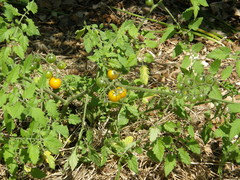
strawchicago z5
8 years agoA better result when I used HomeDepot cow-manure (Moo-manure), which black, loamy, and fluffy. I also mixed in COARSE SAND, the result is a dark-green & healthy tomato, this was planted 4th of July as a baby-plant, and it's catching up with the previous pale tomato (planted mid-May). Both pics. are taken today, July 15.
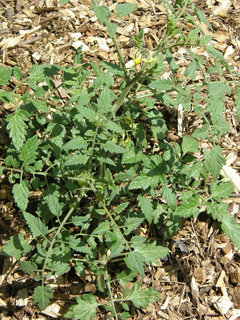







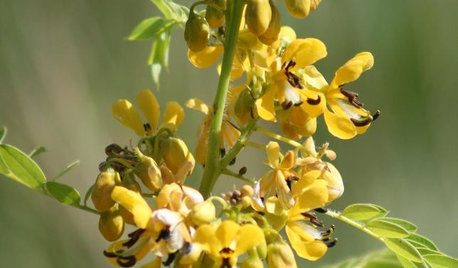








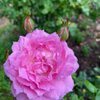
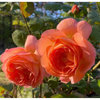

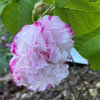
bluegirl_gwOriginal Author